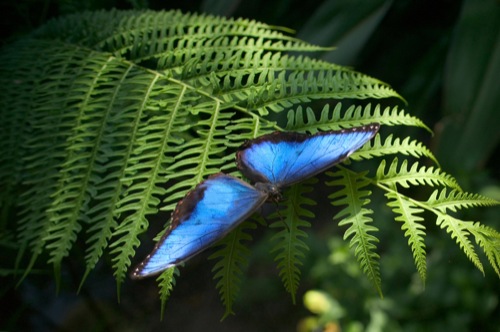
Courtesy Meijer Gardens
In his visions of future blessings for Israel, the prophet Ezekiel saw a place where “there will grow all kinds of trees for food. Their leaves will not wither, nor their fruit fail, but they will bear fresh fruit every month, because the water for them flows from the sanctuary.”
Conservatories and botanical gardens provide a place where flowers and plants “will not wither” and trees “will bear fresh fruit every month,” but indoor gardens also offer sanctuary for the spirit during cold, gray winter days. The warmth, color and fragrance found at indoor botanical gardens provide refuge for the body, reprieve for the mind and respite for the soul.
Atlanta Botanical Garden
[ Atlanta ]
Atlanta Botanical Garden’s Dorothy Chapman Fuqua Conservatory opened in March 1989, a gift from Atlanta businessman J.B. Fuqua in honor of his wife.
The conservatory is divided into five main display areas — the main lobby, the tropical rotunda, the desert house, special exhibits and the Orangerie — and the organization gives priority to plants that are rare, threatened or endangered.
The Orangerie features trees that have been economically beneficial to the world, such as gum, coffee and cacao trees, said Lawton Fairchild, registration coordinator. The tropical rotunda provides a journey into a tropical rain forest.
Atlanta’s mild climate means visitors can enjoy one of the botanical garden’s newest additions year-round: the 40-foot-high walkway built in 2007 that allows guests to stroll through the canopy of a Georgia woodland forest.
“Orchid Daze: Surreal Beauty” opens February 9 and runs through April 14. Inspired by artists such as Salvador Dali, fanciful orchid displays in the conservatory lobby and the Orchid Center are juxtaposed with mirrors and odd objects, such as umbrellas and shoes, to offer visitors a “fun take on surrealism,” Fairchild said.
www.atlantabotanicalgarden.org
Frederik Meijer Gardens and Sculpture Park
[ Grand Rapids, Michigan ]
With 15,000 square feet and five soaring stories, the sparkling glass and steel conservatory at Meijer Gardens opened in April 1995 and includes a Victorian parlor, a carnivorous plant house, an arid garden and a tropical conservatory.
The Victorian garden parlor showcases palms, ferns and other plants popular during the era, and the carnivorous plant house — the only exhibit in the United States dedicated solely to carnivorous plants — features Venus flytraps, pitcher plants and other species that capture and digest insects to survive.
A stone archway divides the arid garden into two areas. One side features plants from the Americas and Australia’s arid regions; the other side features plants from Africa, Asia and the Middle East, as well as a seven-foot-tall replica of a termite mound.
The tropical conservatory displays plants and trees from more than five continents, among them flowering plumbago, jasmine, fig trees and palm trees, in a setting filled with splashing waterfalls and misty steam beds.
The tropical conservatory is also home to one of Meijer Gardens’ signature events, “Butterflies Are Blooming,” which runs February 1 through April 30.
Now in its 18th year, the exhibit features thousands of butterflies flying freely in the 80-degree conservatory. Visitors can watch more than 40 different species of butterflies and moths as they drink nectar from flowers and feeding stations. The Butterfly Bungalow houses the 800 chrysalides and cocoons that are delivered to the conservatory each week.










